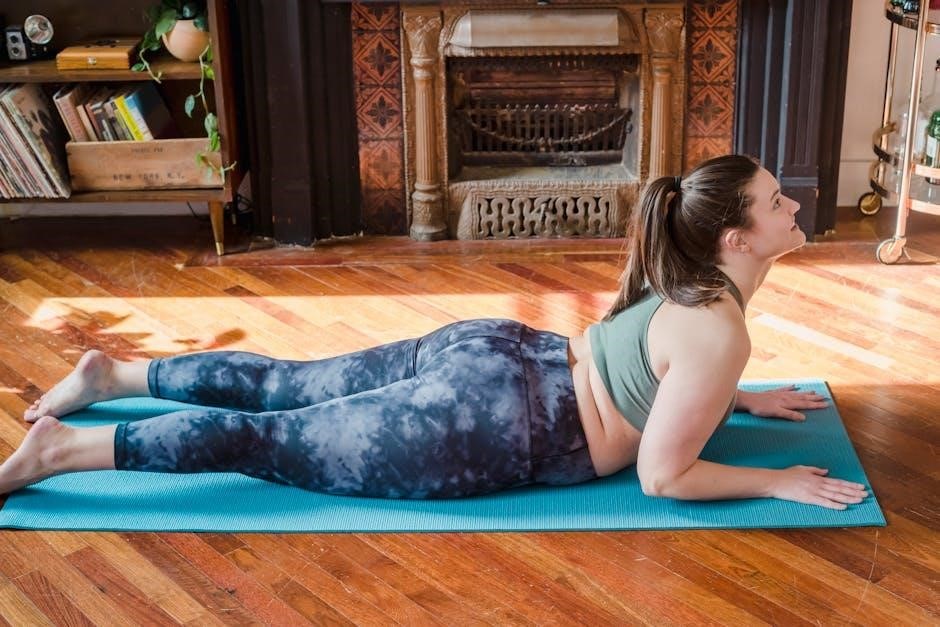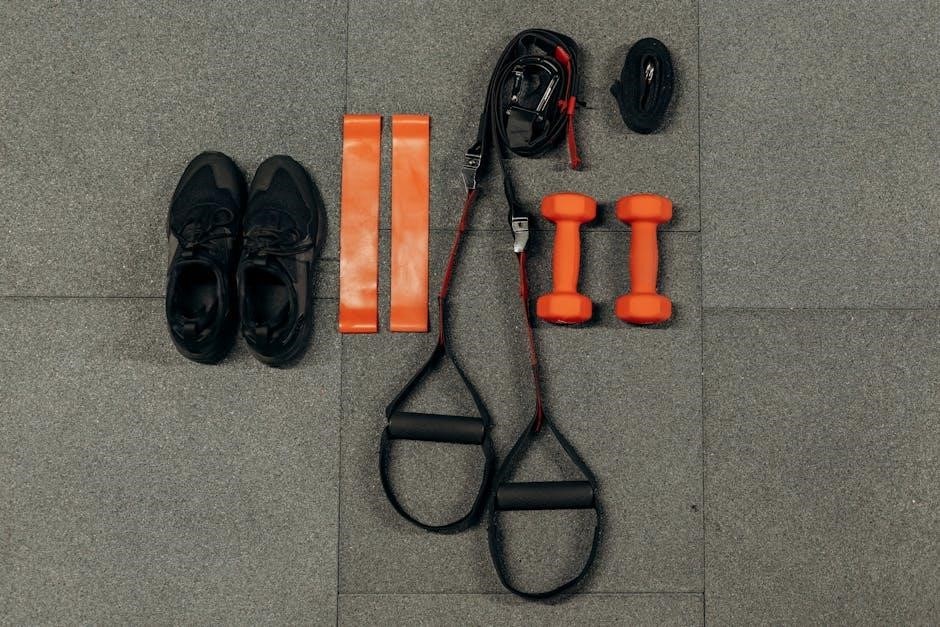A cardiac rehab home exercise program is a structured plan designed to improve heart health through safe and effective physical activities. It complements formal rehabilitation by allowing patients to continue exercises at home, promoting long-term cardiovascular benefits and overall well-being. These programs are tailored to individual needs and often include aerobic exercises, strength training, and flexibility routines, guided by healthcare providers to ensure safety and progress.
Importance of Exercise in Cardiac Rehabilitation
Exercise is a cornerstone of cardiac rehabilitation, improving heart function, reducing symptoms, and enhancing overall quality of life. It helps manage conditions like heart failure, coronary artery disease, and high blood pressure, while also lowering the risk of future cardiac events. Regular physical activity strengthens the heart muscle, improves circulation, and increases energy levels. Exercise also supports weight management, improves mental health, and reduces stress, all of which are critical for heart health. By incorporating exercise into daily routines, patients can achieve better long-term outcomes, regain independence, and return to daily activities and work more effectively.
Benefits of a Home-Based Exercise Program
A home-based exercise program offers convenience, flexibility, and comfort, allowing patients to continue their cardiac rehabilitation safely at home. It eliminates the need for frequent clinic visits, reducing time and travel costs. Home exercises can be tailored to individual schedules, making it easier to maintain consistency. Additionally, exercising in a familiar environment can boost confidence and motivation. Regular home-based exercise helps improve heart function, increases energy levels, and supports overall cardiovascular health. It also fosters independence, enabling patients to take an active role in their recovery. This approach ensures uninterrupted progress, even when accessing traditional rehab centers is challenging, promoting long-term heart health and well-being.

Key Components of a Cardiac Rehab Home Exercise Program
A cardiac rehab home exercise program typically includes aerobic exercises, strength training, flexibility routines, and heart rate monitoring to ensure safe and effective progress in heart health.
Aerobic Exercises for Cardiac Health
Aerobic exercises are central to cardiac rehabilitation, enhancing heart function and improving circulation. Activities like brisk walking, swimming, and cycling are recommended, as they strengthen the heart muscle and boost endurance. These exercises are typically performed at moderate intensity, with guidelines suggesting at least 30 minutes per session, most days of the week. Patients are advised to start slowly, gradually increasing duration and intensity under medical supervision. Monitoring heart rate and symptoms ensures safety, while consistent practice fosters long-term cardiovascular health and reduces the risk of future heart issues.
Strength Training Exercises for Cardiac Patients
Strength training is a vital component of cardiac rehabilitation, focusing on improving muscular endurance and overall physical function. Patients are often advised to use resistance bands, light dumbbells, or bodyweight exercises like chair squats or wall push-ups. These exercises are designed to enhance strength without overexerting the heart. Typically, strength training sessions are recommended 2-3 times a week, with at least 48 hours of rest between sessions. Guidance from clinical exercise physiologists ensures safety and effectiveness. Patients are encouraged to start with light resistance and gradually progress, avoiding high-intensity workouts. Proper form and breathing techniques are emphasized to prevent injury and maximize benefits for cardiac health.
Flexibility and Stretching Exercises
Flexibility and stretching exercises are essential for improving range of motion, reducing muscle tension, and enhancing overall mobility in cardiac patients. These exercises are typically low-intensity and can be performed safely at home. Examples include seated stretches, shoulder rolls, and gentle yoga poses. Patients are encouraged to hold each stretch for 20-30 seconds to maximize benefits. Stretching routines should be done 3-4 times weekly, ideally after light aerobic activity when muscles are warm. Proper breathing techniques are emphasized to promote relaxation and avoid discomfort. Flexibility exercises complement strength and aerobic training, contributing to a well-rounded cardiac rehabilitation program and improved quality of life.

Safety Guidelines for Home Exercise
Safety guidelines for home exercise emphasize pre-exercise checks, monitoring heart rate, and stopping if symptoms like chest pain or dizziness occur. Always consult a healthcare provider before starting.
Pre-Exercise Checks and Safety Precautions
Before starting any home exercise, individuals should perform a series of pre-exercise checks to ensure safety. This includes assessing current symptoms such as chest pain, shortness of breath, or dizziness. Blood pressure and heart rate should be measured and compared to prescribed limits. It is crucial to avoid exercising in extreme temperatures or when feeling unwell. Consulting with a healthcare provider before beginning a new routine is essential, especially for those with specific medical conditions. Adhering to these precautions helps minimize risks and ensures a safe and effective workout experience tailored to individual health needs.
Monitoring Heart Rate and Symptoms During Exercise
Monitoring heart rate and symptoms during exercise is crucial for safety and effectiveness in a cardiac rehab home program. Use a pulse checker or wearable device to track heart rate, ensuring it stays within the prescribed target zone. Pay attention to symptoms like chest pain, dizziness, or extreme breathlessness, and stop exercising immediately if they occur. Regularly compare your heart rate to your target zone, adjusting intensity as needed. This practice helps prevent overexertion and ensures a safe workout. Guidance from clinical exercise physiologists can also help interpret heart rate data and symptoms, enabling adjustments to your routine for optimal cardiac health and safety.

Designing Your Home Exercise Program
Designing a home exercise program involves setting realistic goals, incorporating aerobic exercises, strength training, and flexibility routines. Tailor activities to individual health needs and fitness levels, ensuring progression and safety.
Setting Realistic Goals and Schedules
Setting realistic goals and schedules is crucial for a successful home exercise program. Start with achievable objectives, such as 10-15 minute sessions, 2-3 times a week, and gradually increase duration and frequency. Consider your current fitness level, health status, and daily routine when planning. Break larger goals into smaller, manageable tasks to maintain motivation. For example, aim to walk 10 minutes daily and progressively extend the time. Consistency is key, so schedule exercises at convenient times to ensure adherence. Regularly review and adjust goals with your healthcare provider to track progress and stay motivated. This structured approach ensures sustainability and success.
Progressing Your Exercise Routine Safely
Progressing your exercise routine safely involves gradual increases in intensity, duration, or frequency over time. Start with low-intensity activities and slowly build up to avoid overexertion. Monitor your heart rate and symptoms, such as chest pain or shortness of breath, to ensure you’re within a safe range. Only advance your routine after consulting with your healthcare provider. Strength training can be introduced with light weights or resistance bands, gradually increasing as your body adapts. Rest days are essential to allow your body to recover. Always prioritize your physical limits and avoid pushing too hard, as this can lead to setbacks. Progress should be steady and tailored to your individual needs.

Incorporating Daily Activities into Your Routine
Incorporating daily activities, such as household chores and walking, enhances cardiac health. These simple tasks contribute to your exercise plan, promoting consistency and overall well-being without formal workout routines.
Using Household Chores as Part of Your Exercise Plan
Household chores can be an effective way to incorporate physical activity into your daily routine, supporting your cardiac rehab goals. Tasks like vacuuming, mopping, or gardening can elevate your heart rate and improve endurance. Breaking these activities into shorter sessions, such as 10-15 minutes, can help you gradually increase your exercise capacity. Additionally, chores like carrying groceries or climbing stairs can strengthen muscles and boost cardiovascular health. By viewing chores as exercise opportunities, you can maintain a consistent activity level while managing daily responsibilities, contributing to a heart-healthy lifestyle without needing structured workout time.
Walking and Other Low-Impact Activities
Walking is a cornerstone of cardiac rehab home exercise programs due to its simplicity and effectiveness. Starting with short sessions of 7-10 minutes, you can gradually increase to 30 minutes daily. This low-impact activity strengthens the heart, improves circulation, and enhances endurance. Brisk walking can elevate your heart rate, providing aerobic benefits while minimizing stress on joints. Other low-impact activities, such as swimming or cycling, can also be incorporated, offering variety and reducing monotony. These exercises are easy to perform at home or in your neighborhood, making them accessible and sustainable for long-term heart health management. Consistency is key to achieving lasting benefits.

Monitoring and Tracking Progress
Tracking your progress through an exercise journal helps monitor improvements in heart rate, endurance, and overall health. Wearable devices provide real-time data, enhancing accountability and safety.
Keeping an Exercise Journal
Keeping an exercise journal is a valuable tool for tracking your progress in a cardiac rehab home exercise program. By recording your daily workouts, including the type, duration, and intensity of exercises, you can monitor improvements in your cardiovascular health. Note any symptoms experienced during or after exercise, such as chest pain or shortness of breath. This journal also helps identify patterns and motivates consistency. Regularly reviewing your entries with your healthcare provider ensures your program remains safe and effective. Over time, the journal becomes a testament to your hard work and achievements, reinforcing the benefits of long-term adherence to your exercise routine.
Using Wearable Devices for Heart Rate Monitoring
Wearable devices, such as smartwatches or fitness trackers, are excellent tools for monitoring heart rate during home exercises in a cardiac rehab program. These devices provide real-time feedback, helping you stay within a safe heart rate zone recommended by your healthcare provider. By tracking your heart rate, you can adjust the intensity of your workout to avoid overexertion. Additionally, many devices record data such as exercise duration and calories burned, offering a comprehensive view of your progress. Sharing this data with your clinical team can also help refine your exercise plan, ensuring it remains effective and tailored to your needs for optimal cardiac health.

Role of Healthcare Providers in Home Rehab
Healthcare providers play a crucial role in guiding and monitoring home-based cardiac rehab. They create personalized plans, track progress, and ensure safety, helping patients stay consistent and motivated while providing necessary adjustments for optimal heart health.
Guidance from Clinical Exercise Physiologists
Clinical exercise physiologists provide expert guidance for cardiac rehab home exercise programs. They assess individual fitness levels, medical history, and goals to create personalized plans. Physiologists ensure exercises align with American College of Sports Medicine (ACSM) guidelines, focusing on safety and effectiveness. They also monitor progress, adjust routines, and offer support to maintain motivation. Regular communication helps address concerns and prevents complications. Their expertise ensures patients perform exercises correctly, maximizing benefits while minimizing risks. This tailored approach helps patients achieve long-term heart health and independence in their fitness journey.
Telehealth Support for Home-Based Programs
Telehealth has become a vital component of home-based cardiac rehabilitation, enabling remote monitoring and guidance. Through virtual platforms, healthcare providers can deliver personalized exercise plans, track progress, and offer real-time feedback. This approach ensures continuity of care, especially for those with limited access to in-person facilities. Telehealth also allows for timely adjustments to exercise routines, addressing patient concerns and preventing potential complications. Regular check-ins via video calls or mobile apps help maintain motivation and adherence to the program. This innovative method supports patients in achieving their cardiac rehab goals safely and effectively from the comfort of their homes.

Maintaining Motivation and Adherence
Setting realistic goals, celebrating progress, and establishing a consistent routine are key strategies to maintain motivation and adherence in a home exercise program.

Strategies to Stay Consistent with Home Exercises
Consistency in home exercises requires setting specific, achievable goals and creating a structured schedule. Incorporating activities into daily routines, such as during commercial breaks while watching TV or right after breakfast, can help maintain regularity. Tracking progress through journals or wearable devices provides motivation and accountability. Social support, like exercising with a family member or joining online groups, can also enhance adherence. Celebrating small milestones and rewarding oneself for sustained effort further boosts commitment. Establishing a dedicated exercise space at home and minimizing distractions can create a conducive environment for sticking to the program.
Overcoming Common Barriers to Exercise
Common barriers to exercise include lack of time, motivation, or energy, as well as fear of injury or discomfort; To overcome these, patients can start with short, manageable sessions and gradually increase duration. Setting realistic expectations and focusing on progress rather than perfection can build confidence. Education on proper techniques and safety guidelines can alleviate fears, while incorporating enjoyable activities like walking or swimming makes exercise more engaging. Additionally, leveraging telehealth support and guidance from clinical physiologists can provide personalized strategies to stay on track and address specific challenges, ensuring a sustainable and effective home exercise routine.

Consistent participation in a cardiac rehab home exercise program leads to long-term health improvements. Patients should continue prioritizing physical activity and consult healthcare providers for further guidance and support.
Long-Term Benefits of Continuing Exercise
Continuing exercise after cardiac rehabilitation offers numerous long-term benefits, including improved cardiovascular health, enhanced physical strength, and better overall well-being. Regular physical activity helps maintain a healthy heart rhythm, reduces the risk of future cardiac events, and promotes mental health. By incorporating exercise into daily routines, individuals can regain independence, reduce dependency on medications, and improve their quality of life. Consistency is key to achieving these benefits, as sustained effort leads to lasting improvements in heart function and overall health outcomes, making exercise a vital component of long-term cardiac care and management.
Resources for Further Support and Information
For further support and information on cardiac rehab home exercise programs, numerous resources are available. Booklets and guides, such as those provided by cardiac rehabilitation centers, offer detailed exercise plans and safety tips. Websites like WebMD and hospital-affiliated portals provide comprehensive insights and printable materials. Additionally, clinical exercise physiologists and healthcare providers can offer personalized advice. Telehealth platforms and mobile apps also serve as valuable tools for remote monitoring and guidance. Many programs include resources like exercise journals and wearable devices to track progress. Utilizing these resources ensures continued support and helps individuals maintain a consistent and effective exercise routine for long-term heart health.
